Phytosociological Research and Meaningful Learning: Constructivist Approaches for Teaching Vegetation
Abstract
1. Introduction
1.1. Phytosociological Background
- Non-endangered habitats: Communities with broad distribution, lacking endemic or rare species, and not under significant threat.
- Fragile habitats: Communities with limited distribution, endemic species, or unique synecology, which are highly susceptible to degradation or disappearance, necessitating conservation measures.
1.2. Vegetation Education
2. Materials and Methods
2.1. Analysis of the Phytosociological Research Method
- Analytical Phase: This phase requires the meticulous selection of sampling plots to ensure homogeneity and representativeness.
- Synthetic Phase: Data collected in the analytical phase are integrated to develop a comprehensive understanding of the plant community.
- Forests: Mediterranean zones require plot sizes of 300–500 m2, while tropical and subtropical zones necessitate larger areas of approximately 1000–2000 m2.
- Shrublands: Plot sizes range from 50–200 m2.
- Grasslands: Optimal plot sizes are between 0.5–2 m2.
2.2. Teaching the Phytosociological Method to Students
- The concept of vegetation associations.
- Methods for calculating diversity indices.
- The ecological and conservation implications of phytosociological studies.
- Practical applications of the EU Habitats Directive.
- 1.
- To what extent do you believe there is a relationship between diversity and conservation?
- 2.
- Do you think it is important to understand an ecosystem’s diversity to assess its conservation status?
- 3.
- Do you consider that, in a plant community, a higher number of species indicates better conservation?
- 4.
- Do you know how to calculate the minimum area?
- 5.
- Do you know how to perform a phytosociological inventory?
- 6.
- Do you know how to calculate Alpha, Beta, and Gamma diversity?
- 7.
- What sciences are involved in the concept of biodiversity?
- 8.
- Define the concept of biodiversity.
- 9.
- Do you know the differences between characteristic and companion species?
- 10.
- Do you know what sustainable development means?
- 11.
- Define sustainable development.
- 12.
- The set of terrestrial ecosystems that, by sharing similar climatic conditions, host the same types of living beings is called?
- 13.
- What is the action plan to conserve biodiversity?
- 14.
- What is biodiversity?
- 15.
- How is biodiversity measured?
- 16.
- What are endemic species?
- 17.
- What is a biodiversity hotspot?
- Formulating new hypotheses.
- Conducting additional observations.
- Interpreting observed phenomena through “feedback” and “feedforward” mechanisms.
3. Results
3.1. Phytosociological Analysis
3.2. Diversity Measures
3.3. Learning Outcomes
4. Discussion
4.1. Diversity Analysis
4.2. Analysis of the Teaching-Learning Process
5. Conclusions
5.1. Conclusion on the Research
5.2. Conclusion on the Teaching and Learning Process
Author Contributions
Funding
Institutional Review Board Statement
Data Availability Statement
Conflicts of Interest
References
- Theurillat, J.P.; Willner, W.; Fernández-González, F.; Bültmann, H.; Čarni, A.; Gigante, D.; Mucina, L.; Weber, H. International Code of Phytosociological Nomenclature. Appl. Veg. Sci. 2020, 24, e12491. [Google Scholar] [CrossRef]
- Cano Ortiz, A.; Piñar Fuentes, J.C.; Ighbareyeh, J.M.H.; Quinto Canas, R.; Cano, E. Aspectos Didácticos en la Enseñanza de Conceptos Geobotánicos. IJHSSE 2021, 8, 271–276. [Google Scholar] [CrossRef]
- Cañas, A.; Martín-Díaz, M.; Nieda, J. Competencia en el Conocimiento y la Interacción en el Mundo Físico. La Competencia Científica; Alianza Editorial: Madrid, Spain, 2007. [Google Scholar]
- García Barros, S.; Martínez Losada, C.; Rivadulla López, J. Actividades de textos excolares. Su contribución al desarrollo de la competencia científica. Enseñanza Cienc. 2021, 39, 219–238. [Google Scholar] [CrossRef]
- Ivanova, N. Global Overview of the Application of the Braun-Blanquet Approach in Research. Forests 2024, 15, 937. [Google Scholar] [CrossRef]
- Rivas Martínez, S. Memoria del Mapa de Series de Vegetación de España 1:400.000. Ministerio de Agricultura, Pesca y Alimentación; I.C.O.N.A.: Madrid, Spain, 1987; p. 268. [Google Scholar]
- Rivas-Martínez, S.; Díaz, T.E.; Fernández-González, F.; Izco, J.; Loidi, J.; Lousa, M.; Penas, A. Vascular PlantCommunities of Spain and Portugal. Itinera Geobot. 2002, 15, 5–922. [Google Scholar]
- Rivas-Martínez, S. Mapa de series, geoseries y geopermaseries de vegetación de España. Parte I. Itinera Geobot. 2007, 17, 5–436. [Google Scholar]
- Rivas-Martínez, S. Mapa de series, geoseries y geopermaseries de vegetación de España. Parte II. Itinera Geobot. 2011, 18, 425–800. [Google Scholar]
- Pinto Gomes, C.J.; Paiva Ferreira, R. Flora e Vegetaçao Barrocal Algarvio, Tavira-Portimao. Publ. Comissao de Coordinaçao e Desenvolvimento Regioal do Alvarve; Comissão e Coordenação e Desenvolvimento Regional do Algarve: Faro, Portugal, 2005; pp. 1–353. [Google Scholar]
- Lazare, J.-J. Phytosociologíe dynamico-catenal et gestión de la biodiversité. Acta Bot. Gall. 2009, 156, 49–61. [Google Scholar]
- Raposo, M.; Mendes, P.; Cano Ortiz, A.; Pinto Gomes, C.J. Séries de Vegetação prioritárias para a conservação no centro e sul de Portugal continental. Botanique 2016, 1, 113–148. [Google Scholar]
- Quinto Canas, R.; Vila-Viçosa, C.; Paiva Ferreira, R.; Cano Ortiz, A.; Pinto Gomes, C.J. The Algarve (Portugal) climatophilous vegetation series: A base documentto theplanning, management and nature conservation. Acta Bot. Gall. 2012, 159, 289–298. [Google Scholar] [CrossRef]
- Cano, E.; Musarella, C.M.; Cano-Ortiz, A.; del Río, S.; Rodríguez Meireles, C.; Raposo, M.; Pinto Gomes, C.J. Contribution to the iberian thermomediterranean oak woods (Spain, Portugal): The importance of their teaching for the training of experts in environmental management. Plant Biosyst. 2024, 58, 1285–1305. [Google Scholar] [CrossRef]
- Cano, E.; Musarella, C.M.; Cano-Ortiz, A.; Piñar Fuentes, J.C.; Rodríguez Torres, A.; del Río, S.; Pinto Gomes, C.J.; Quinto Canas, R.; Spampinato, G. Geobotanical Study of the Microforests of Juniperus oxycedrus subsp. badia in the Central and Southern Iberian Peninsula. Sustainability 2019, 11, 1111. [Google Scholar] [CrossRef]
- Chang, H.; Xiong, K.; Zhu, D.; Zhang, Z.; Zhang, W. Ecosystem Services Value Realization and Ecological Industry Design in Scenic Areas of Karst in South China. Forests 2024, 15, 363. [Google Scholar] [CrossRef]
- Rivas Martínez, S. La vegetación de Hordeion leporini es España. Doc. Fitosoc. 1978, 9, 377–392. [Google Scholar]
- Tilbury, D. Environmental education for sustainability: Defining the new focus of environmental education in the 1990s. Environ. Educ. Res. 1995, 1, 195–212. [Google Scholar] [CrossRef]
- Palacios, J.; Amud, N.; Mendoza, D. Implementación de Huertas Escolares como Estrategia de Enseñanza-Aprendizaje de la Biología de Grado Sexto en la Institución Educativa Agrícola de Urabá del Municipio de Chigorodó y de Grado Séptimo de la Institución Educativa Rural Zapata, de Necoclí, Departamento de Antioquia. (Tesis magistral Universidad Pontificia Bolivariana, Medellín). 2016. Available online: https://repository.upb.edu.co/bitstream/handle/20.500.11912/2950/T.G.%20JULIO%20%C3%89DINSON%20PALACIOS%20Y%20OTROS.pdf (accessed on 20 November 2024).
- Monroe, M.C.; Krasny, M.E. Across the Spectrum: Resources for Environmental Education. N. Am. Assoc. Environ. Educ. 2015. Available online: https://www.academia.edu/27500674/Foundation_of_Environmental_Education (accessed on 20 November 2024).
- Caraballo Vidal, I.; Pezelj, L.; Ramos-Álvarez, J.J.; Guillen-Gamez, F.D. Level of Satisfaction with the Application of the Collaborative Model of the Flipped Classroom in the Sport of Sailing. Educ. Sci. 2024, 14, 150. [Google Scholar] [CrossRef]
- Köpeczi-Bócz, T. The Impact of a Combination of Flipped Classroom and Project-Based Learning on the Learning Motivation of University Students. Educ. Sci. 2024, 14, 240. [Google Scholar] [CrossRef]
- Rodríguez Angarita, T.E.; Mora Penagos, W. El Sentido Educativo de los Espacios no Convencionales de Educación (ENCE) Tipo Jardines Botánicos: Un Estudio de Caso. Enseñanza de las Ciencias, nº Extraordinario 2017, pp. 3411–3416. Available online: https://raco.cat/index.php/Ensenanza/article/view/337075 (accessed on 20 November 2024).
- Jia, L.; Wang, M.; Yang, S.; Zhang, F.; Wang, Y.; Li, P.; Ma, W.; Sui, S.; Liu, T.; Wang, M. Analysis of Agricultural Carbon Emissions and Carbon Sinks in the Yellow River Basin Based on LMDI and Tapio Decoupling Models. Sustainability 2024, 16, 468. [Google Scholar] [CrossRef]
- Cano-Ortiz, A.; Piñar Fuentes, J.C.; Leiva Gea, F.; Igbareyech, J.M.H.; Quinto Canas, R.J.; Rodrigues Meireles, C.I.; Raposo, M.; Pinto Gomes, C.J.; Spampinato, G.; Del Río González, S.; et al. How to Reduce the Supply of Nutrients to the Soil, Increase Water Reserves, and Mitigate Climate Change in Agroforestry for Carbon and Ecosystem Management; Jhariya, M.K., Meena, R.S., Banerjee, A., Kumar, S., Raj, A., Eds.; Elsevier: Amsterdam, The Netherlands, 2023; pp. 223–232. Available online: https://shop.elsevier.com/books/agroforestry-for-carbon-and-ecosystem-management/jhariya/978-0-323-95393-1 (accessed on 20 November 2024).
- Álvarez, P.; Vega, P. Actitudes ambientales y conductas sostenibles. Implicaciones para la educación ambiental. Rev. Psicodidáctica 2009, 4, 245–260. [Google Scholar]
- Cantú, P. Educación ambiental y la escuela como espacio educativo para la promoción de la sustentabilidad. Rev. Educ. 2014, 18, 39–52. [Google Scholar]
- Sandoval, M. Comportamiento sustentable y educación ambiental: Una visión desde las prácticas culturales. Rev. Latinoam. Psicol. 2012, 44, 181–196. [Google Scholar]
- EEC. Council directive 92/43/CEE of 21 May 1992 on the conservation of natural habitats and of wild fauna and flora. Off. J. L 1992, 206, 7–50. [Google Scholar]
- Cañal, P. ¿Cómo evaluar la competencia científica? Investig. Esc. 2012, 78, 5–17. [Google Scholar]
- Miño, M.H.; Toia, S.N.; Pérez, G.M.; Gutierrez, T.N.; González Galli, L.M.; Meinardi, E.M. Comparación del conocimiento metacognitivo sobre la lectura de textos de Biología entre estudiantes de la Ciudad de Buenos Aires. Rev. Electrónica Enseñanza Cienc. 2021, 1, 114–134. [Google Scholar]
- Tovar-Gálvez, J.C. Design of Intercultural Teaching Practices for Science Education based on evidence. Enseñanza Cienc. 2021, 39, 99–115. [Google Scholar] [CrossRef]
- Fernández, I.M.; Pires, D.M.; Villamañán, R.M. Educación científica con enfoque ciencia- tecnología-sociedad-ambiente: Construcción de un instrumento de análisis de las directrices curriculares. Form. Univ. 2014, 7, 23–32. [Google Scholar] [CrossRef]
- Bello Benavides, L.O.; Cruz Sánchez, G.E.; Meira Cartera, P.A.; González Gaudiano, E. El cambio climático en el bachillerato. Aportes pedagógicos para su abordaje. Enseñanza Cienc. 2021, 39, 137–156. [Google Scholar] [CrossRef]
- Amblar Frances, P.; Casado Calle, M.J.; Pastor Saavedra, A.; Ramos Calzado, P.; Rodríguez Camino, E. Guide to Regionalized Climate Change Scenarios over Spain from IPCC-AR5 Results; AEMET: Madrid, Spain, 2017. [Google Scholar] [CrossRef]
- IPCC. Climate Change Synthesis Report The Intergovernmental Panel on Climate Change. 2023. Available online: https://www.ipcc.ch/report/ar6/syr/downloads/report/IPCC_AR6_SYR_FullVolume.pdf (accessed on 20 November 2024).
- Da Silva Siltori, P.F.; Lourenzani, W.L.; Satolo, E.G.; Ferreira Caldana, A.C.; Salati Marcondes de Moraes, G.H.; Batista Martins, V.W.; Simon Rampasso, I. Training Future Managers to Address the Challenges of Sustainable Development: An Innovative, Interdisciplinary, and Multiregional Experience on Corporate Sustainability Education. World 2024, 5, 155–172. [Google Scholar] [CrossRef]
- Guerrero Fernández, A.; Rodríguez Marín, F.; López Lozano, L.; Solís Ramírez, E. Alfabetización ambiental en la formación inicial docente: Diseño y validación de un cuestionario. Enseñanza Cienc. 2022, 40, 25–46. [Google Scholar] [CrossRef]
- Forbes, S.H. Holistic Education: An Analysis of Its Ideas and Nature; Brandon (Vermont, EE. UU.): Foundation for Educational Renewal; Resource Center for Redesigning: San Diego, CA, USA, 2003. [Google Scholar]
- Hare, J. La Educación Holística: Una Interpretación para los Profesores de los Programas del IB; Organización del Bachillerato Internacional: Geneva, Switzerland, 2010; pp. 1–8. Available online: https://es.scribd.com/document/177983712/La-educacion-holistica-John-Hare (accessed on 8 November 2024).
- María Domíguez, S. Del Holismo al Constructivismo. Los Grandes Maestros. Revista de Postgrado FACE-UC. 2014, 6, 39–51. Available online: http://www.arje.bc.uc.edu.ve/arj15/art03.pdf (accessed on 20 November 2024).
- Añez de Bravo, M.A. Modelo de aprendizaje holístico del ser: Una propuesta pedagógica en orientación. Rev. Estilos Aprendiz. 2009, 3, 177–195. Available online: https://revistaestilosdeaprendizaje.com/article/view/884/1572 (accessed on 20 November 2024). [CrossRef]
- De Rivas, R.; Vilches, A.; Mayoral., O. Secondary School Students’ Perceptions and Concerns on Sustainability and Climate Change. Climate 2024, 12, 17. [Google Scholar] [CrossRef]
- Chen, Y.; Hong, C.; Yang, Y.; Li, J.; Wang, Y.; Zheng, T.; Zhang, Y.; Shao, F. Mining Social Media Data to Capture Urban Park Visitors’ Perception of Cultural Ecosystem Services and Landscape Factors. Forests 2024, 15, 213. [Google Scholar] [CrossRef]
- Torres, D.; Capote, J. Agroquímicos un problema ambiental global: Uso del análisis químico como herramienta para el monitoreo ambiental. Ecosistemas 2004, 13, 2–6. [Google Scholar]
- Magwegwe, E.; Zivengwa, T.; Zenda, M. Adaptation and Coping Strategies of Women to Reduce Food Insecurity in an Era of Climate Change: A Case of Chireya District. Zimbabwe. Climate 2024, 12, 126. [Google Scholar] [CrossRef]
- Salinas, I.; Guerrero, G.; Satlov., M.; Hidalgo., P. Climate Change in Chile’s School Science Curriculum. Sustainability 2022, 14, 15212. [Google Scholar] [CrossRef]
- Vilches, A.; Gil-Pérez, D. The transition to Sustainability as an urgent objective for overcoming the current systemic crisis. Eureka J. Sci. Educ. Dissem. 2016, 13, 395–407. Available online: http://hdl.handle.net/10498/18296 (accessed on 20 November 2024).
- García Cué, J.L.; Santizo Rincón, J.A.; Alonso García, C.M. Instrumentos de medición de estilos de aprendizaje. Rev. Estilos Aprendiz. 2009, 3, 3–21. Available online: https://revistaestilosdeaprendizaje.com/article/view/886/1574 (accessed on 20 November 2024). [CrossRef]
- Cano Ortiz, A.; Pinto Gomes, C.J.; Esteban, F.J.; Rodríguez Torres, A.; Gonñi, J.; De la Haza, I.; Cano, E. Biodiversity of Hordeion leporini in Portugal: A phytosociological and edaphic analysis. Acta Bot.Gall. 2009, 156, 33–48. [Google Scholar] [CrossRef]
- Cano Ortiz, A.; Biondi, E.; Pinto Gomes, C.J.; Del Río González, S.; Cano, E. Soil and phytosociological caracterisation of grasslands in the western mediterranean. Am. J. Plant Sci. 2014, 5, 3213–3240. [Google Scholar] [CrossRef][Green Version]
- Cano Ortiz, A. Teaching about biodiversity from phytosociology: Evaluation and conservation. Plant Sociol. 2023, 60, 25–37. [Google Scholar] [CrossRef]
- Cano Ortiz, A.; Piñar Fuentes, J.C.; Musarella, C.M.; Cano, E. Educational and socio-economic strategies for the sustainability of iberian mediterranean grasslands. Tansylvanian Rev. 2024, 32, 16588. Available online: https://www.transylvanianreviewjournal.com/index.php/TR/issue/view/65 (accessed on 20 November 2024).
- Braun-Blanquet, J. Fitosociología; Ed. Blume: Madrid, Spain, 1979; pp. 1–820. [Google Scholar]
- Géhu, J.-M.; Rivas-Martínez, S. Notions fondamentales de Phytosociologie. In Syntaxonomie [Berichte der Internationalen Symposien der Internationalen Vereinigung für Vegetationskunde 1980]; Dierschke, H., Ed.; Springer: Dordrecht, The Netherlands, 1981; Volume LI, pp. 5–33. [Google Scholar]
- Montaner-Villalba, S.; Santiago, R.; Bergmann, J. Aprender al revés. Flipped Learning 3.0 y metodologías activas en el aula. Barcelona: Faidós Educación pp. 240. Rev. Interuniv. Investig. Tecnol. Educ. (RIITE) 2018, 7, 98–99. [Google Scholar] [CrossRef]
- Cantó Doménech, J.; Hurtado Soler, A.; Vilches Peña, A. Educación científica más allá del aula. Alambique Didáctica Cienc. Exp. 2013, 74, 76–83. [Google Scholar]
- Nguyen, H.T.T. Implementing Feedforward-based Collaborative Assessment at Higher Education. Athens J. Educ. 2024, 11, 335–352. [Google Scholar] [CrossRef]
- Satrústegui Moreno, A.; Mateo González, E. Mejora del pensamiento crítico en alumnos de ESO a través del aprendizaje basado en problemas en un entorno STEAM. Rev. Estilos Aprendiz. 2023, 16, 19–32. [Google Scholar] [CrossRef]
- de los Santos, J.S.N. Espacios educativos para promover la sustentabilidad y la seguridad escolar. Un estudio entre México y Canadá. Rev. Estilos Aprendiz. 2023, 16, 78–88. [Google Scholar] [CrossRef]
- García Ochoa, C. Percepción de la imagen de marca y nuevos espacios de aprendizaje. Un estudio de caso del nuevo Centro de Formación ESIC Madrid. Rev. Estilos Aprendiz. 2023, 16, 62–77. Available online: https://revistaestilosdeaprendizaje.com/article/view/5816 (accessed on 20 November 2024). [CrossRef]

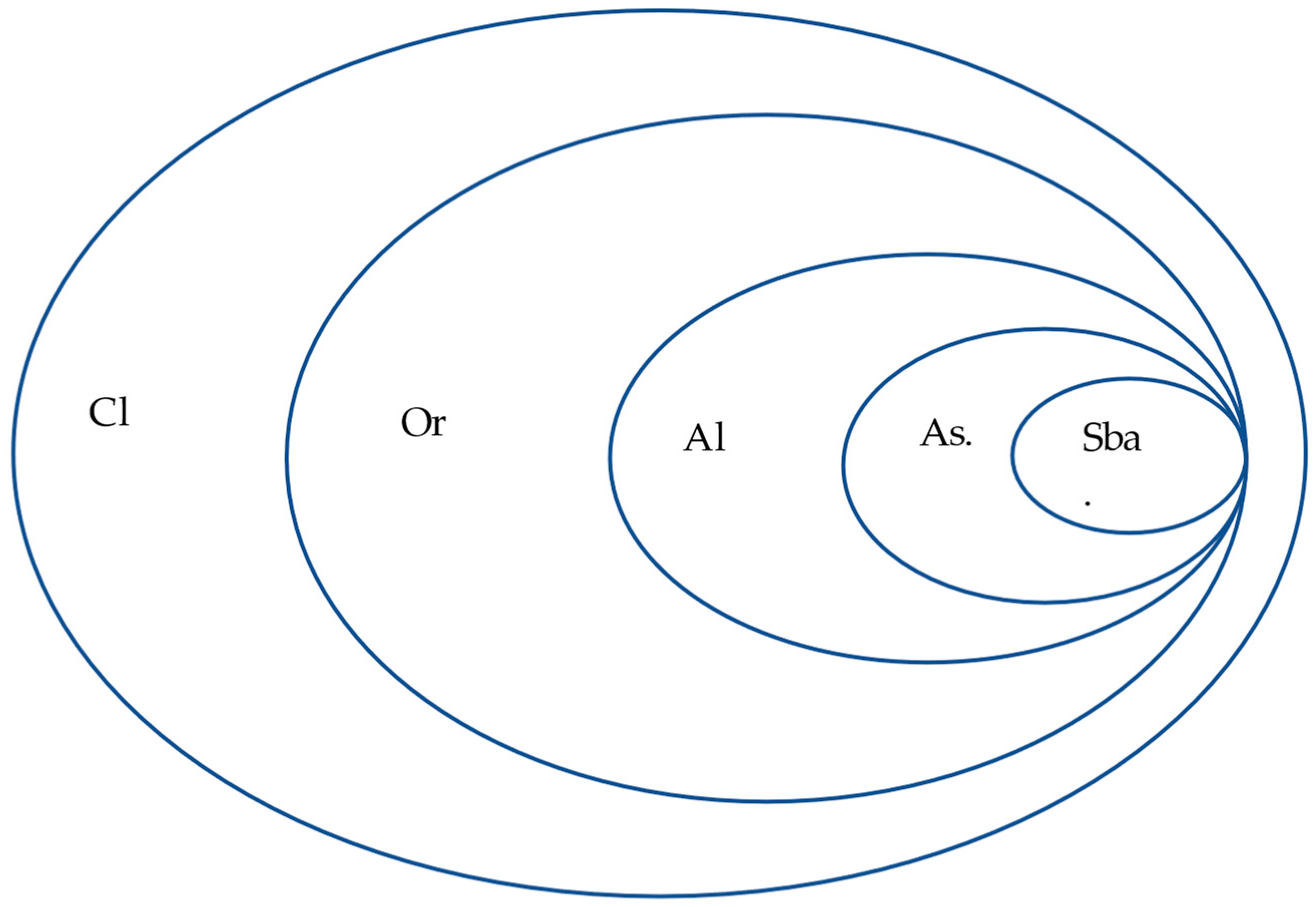
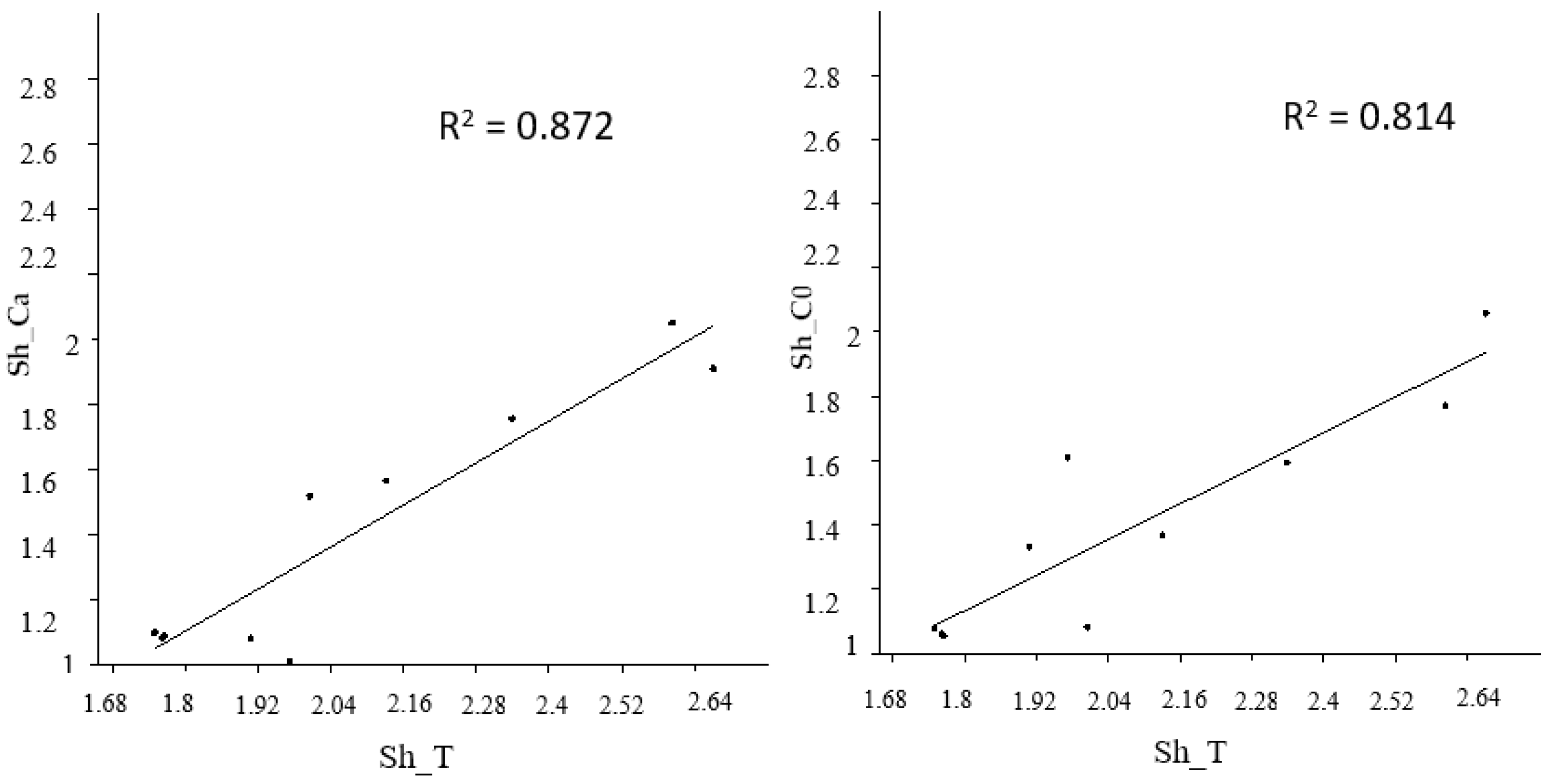
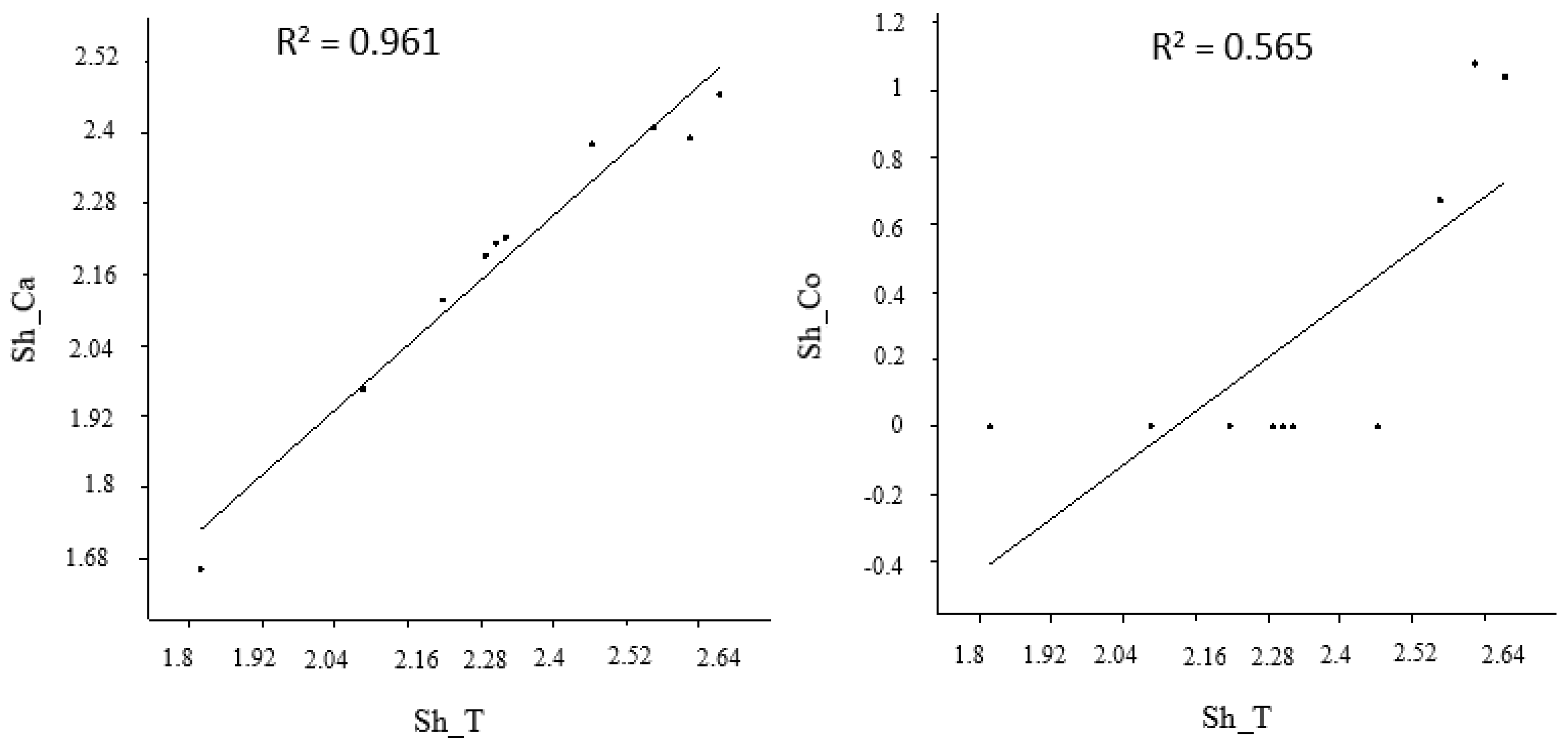
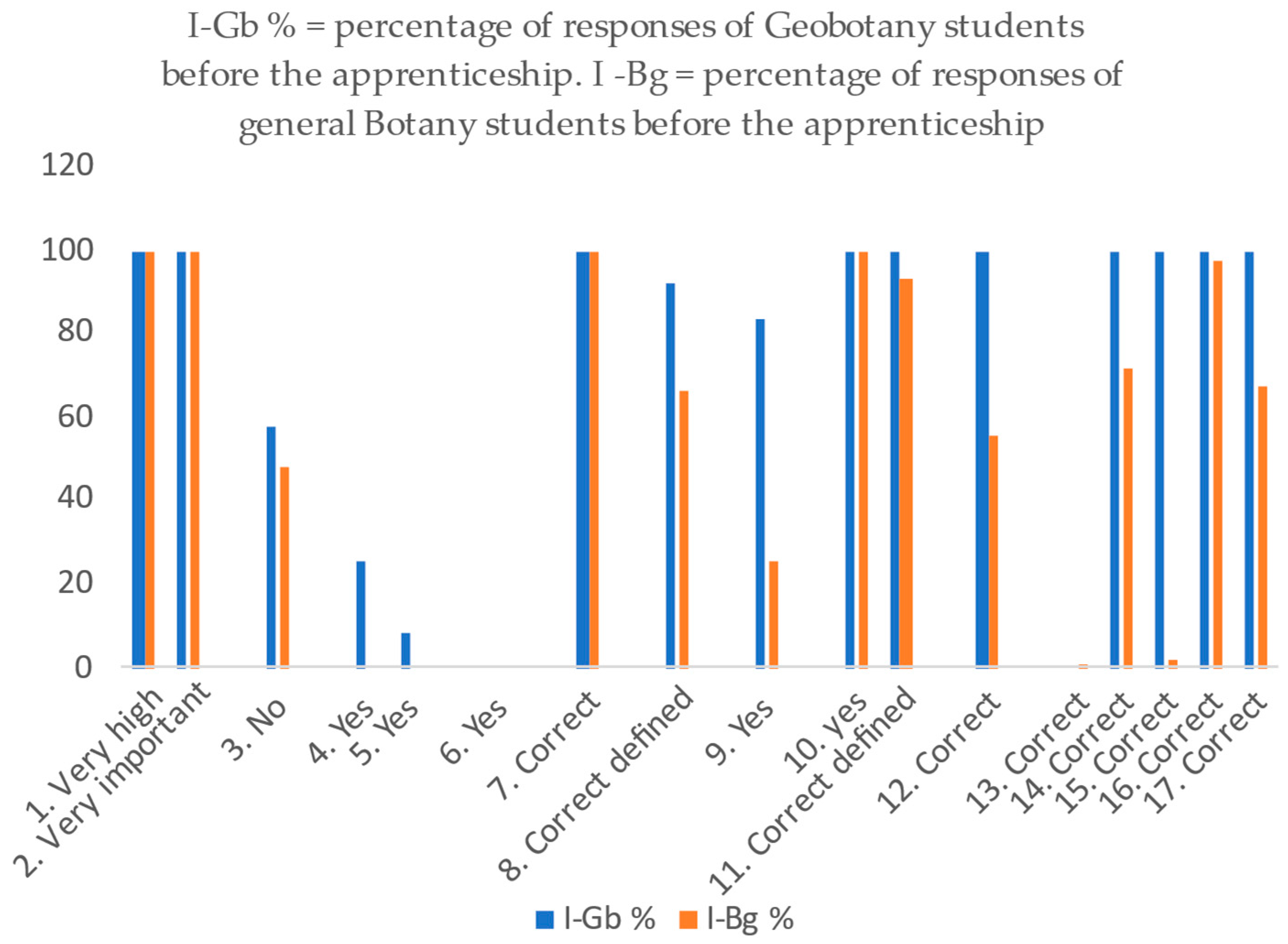
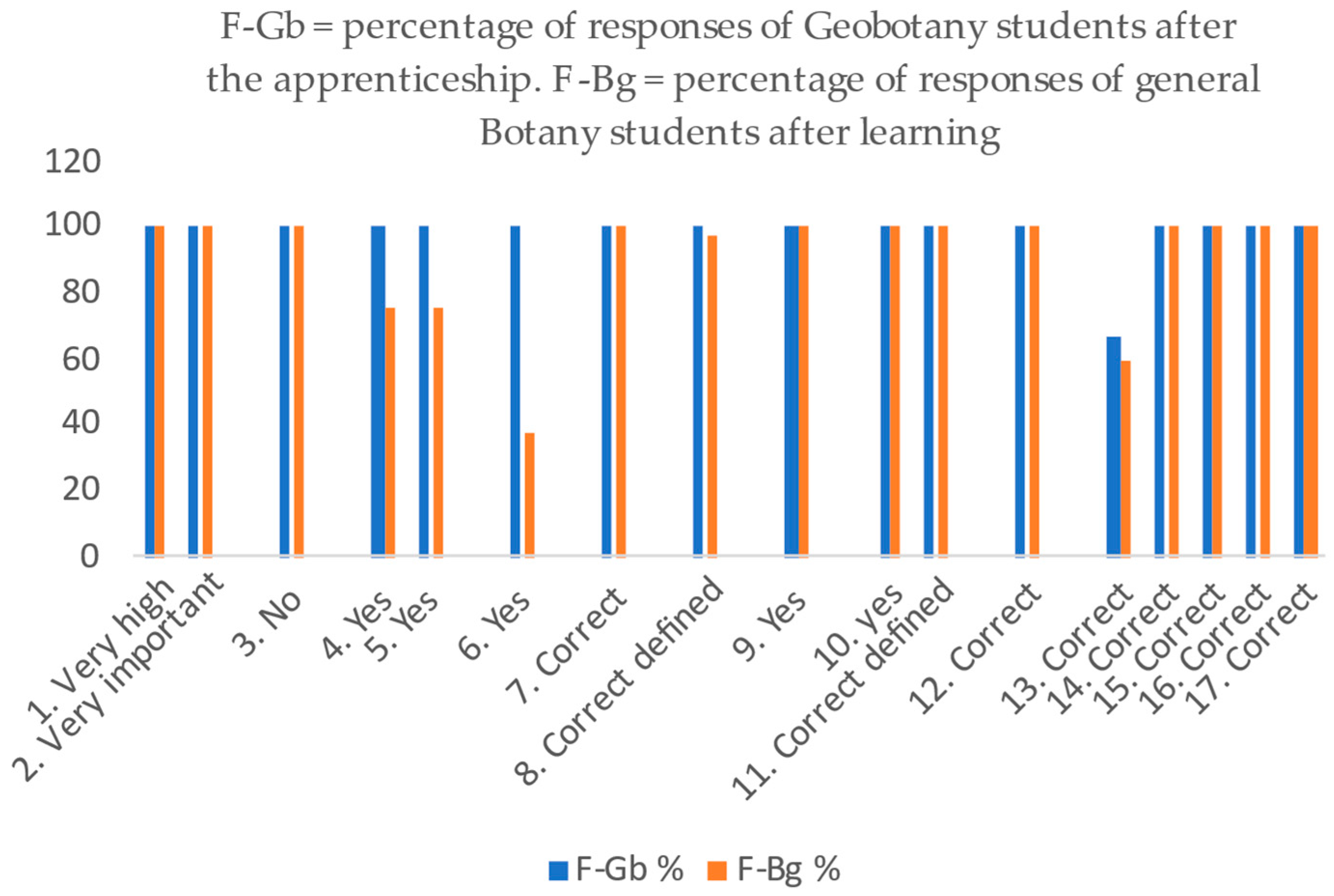
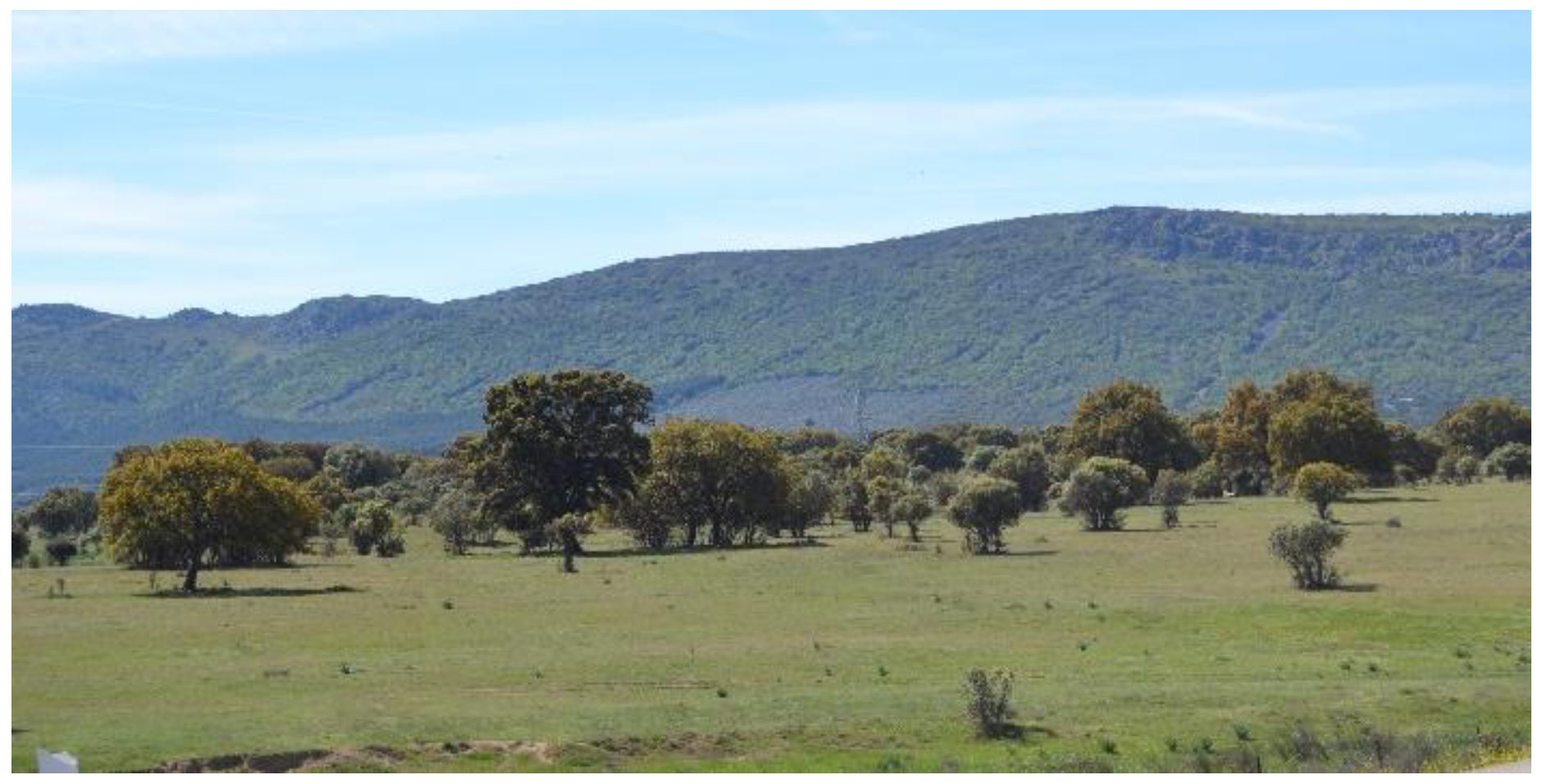
| Inv1 | Inv2 | Inv3 | Inv4 | Inv5 | Inv6 | Inv7 | Inv8 | Inv9 | Inv10 | |
|---|---|---|---|---|---|---|---|---|---|---|
| Shannon_T | 2.131 | 2.339 | 2.671 | 1.972 | 2.603 | 2.005 | 1.762 | 1.908 | 1.765 | 1.749 |
| Shannon_Ca | 1.566 | 1.756 | 1.911 | 1.011 | 2.051 | 1.518 | 1.082 | 1.082 | 1.089 | 1.099 |
| Shannon_Ca2 | 1.696 | 1.895 | 2.258 | 1.834 | 2.059 | 1.542 | 1.587 | 1.754 | 1.579 | 1.564 |
| Shannon_Co | 1.369 | 1.594 | 2.059 | 1.609 | 1.772 | 1.082 | 1.061 | 1.332 | 1.055 | 1.079 |
| Shannon_Ca-Co | 0.197 | 0.162 | −0.148 | −0.598 | 0.279 | 0.436 | 0.021 | −0.25 | 0.034 | 0.02 |
| Inv1 | Inv2 | Inv3 | Inv4 | Inv5 | Inv6 | Inv7 | Inv8 | Inv9 | Inv10 | |
|---|---|---|---|---|---|---|---|---|---|---|
| Shannon_T | 2.566 | 2.674 | 2.463 | 2.216 | 2.321 | 2.288 | 2.305 | 2.085 | 1.818 | 2.624 |
| Shannon_Ca | 2.408 | 2.463 | 2.38 | 2.117 | 2.223 | 2.192 | 2.213 | 1.967 | 1.662 | 2.39 |
| Shannon_Ca2 | 1.305 | 1.461 | 0.9596 | 0.5297 | 0.9949 | 0.9923 | 0.984 | 0.9596 | 0.5297 | 1.481 |
| Shannon_Co | 0.673 | 1.04 | 0 | 0 | 0 | 0 | 0 | 0 | 0 | 1.079 |
| Shannon_Ca-Co | 1.735 | 1.423 | 2.38 | 2.117 | 2.223 | 2.192 | 2.213 | 1.967 | 1.662 | 1.311 |
| I-Gb % | I-Bg % | F-Gb % | F-Bg % | |
|---|---|---|---|---|
| 1. Very high | 100 | 100 | 100 | 100 |
| 2. Very important | 100 | 100 | 100 | 100 |
| 3. No | 58 | 48 | 100 | 100 |
| 4. Yes | 25 | 0 | 100 | 76 |
| 5. Yes | 8 | 0 | 100 | 76 |
| 6. Yes | 0 | 0 | 100 | 38 |
| 7. Correct | 100 | 99 | 100 | 100 |
| 8. Correct defined | 92 | 66 | 100 | 98 |
| 9. Yes | 83 | 25 | 100 | 100 |
| 10. yes | 100 | 100 | 100 | 100 |
| 11. Correct defined | 100 | 93 | 100 | 100 |
| 12. Correct | 100 | 55 | 100 | 100 |
| 13. Correct | 0 | 1 | 67 | 60 |
| 14. Correct | 100 | 72 | 100 | 100 |
| 15. Correct | 100 | 2 | 100 | 100 |
| 16. Correct | 100 | 97 | 100 | 100 |
| 17. Correct | 100 | 67 | 100 | 100 |
Disclaimer/Publisher’s Note: The statements, opinions and data contained in all publications are solely those of the individual author(s) and contributor(s) and not of MDPI and/or the editor(s). MDPI and/or the editor(s) disclaim responsibility for any injury to people or property resulting from any ideas, methods, instructions or products referred to in the content. |
© 2025 by the authors. Licensee MDPI, Basel, Switzerland. This article is an open access article distributed under the terms and conditions of the Creative Commons Attribution (CC BY) license (https://creativecommons.org/licenses/by/4.0/).
Share and Cite
Cano-Ortiz, A.; Musarella, C.M.; Cano, E. Phytosociological Research and Meaningful Learning: Constructivist Approaches for Teaching Vegetation. Diversity 2025, 17, 172. https://doi.org/10.3390/d17030172
Cano-Ortiz A, Musarella CM, Cano E. Phytosociological Research and Meaningful Learning: Constructivist Approaches for Teaching Vegetation. Diversity. 2025; 17(3):172. https://doi.org/10.3390/d17030172
Chicago/Turabian StyleCano-Ortiz, Ana, Carmelo Maria Musarella, and Eusebio Cano. 2025. "Phytosociological Research and Meaningful Learning: Constructivist Approaches for Teaching Vegetation" Diversity 17, no. 3: 172. https://doi.org/10.3390/d17030172
APA StyleCano-Ortiz, A., Musarella, C. M., & Cano, E. (2025). Phytosociological Research and Meaningful Learning: Constructivist Approaches for Teaching Vegetation. Diversity, 17(3), 172. https://doi.org/10.3390/d17030172









